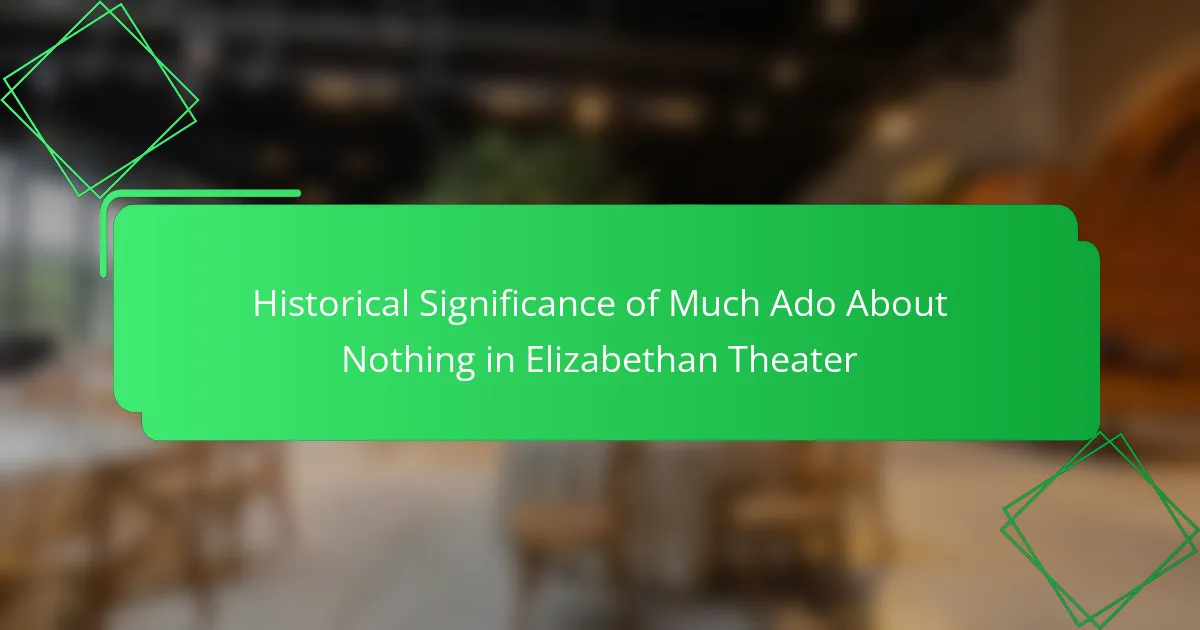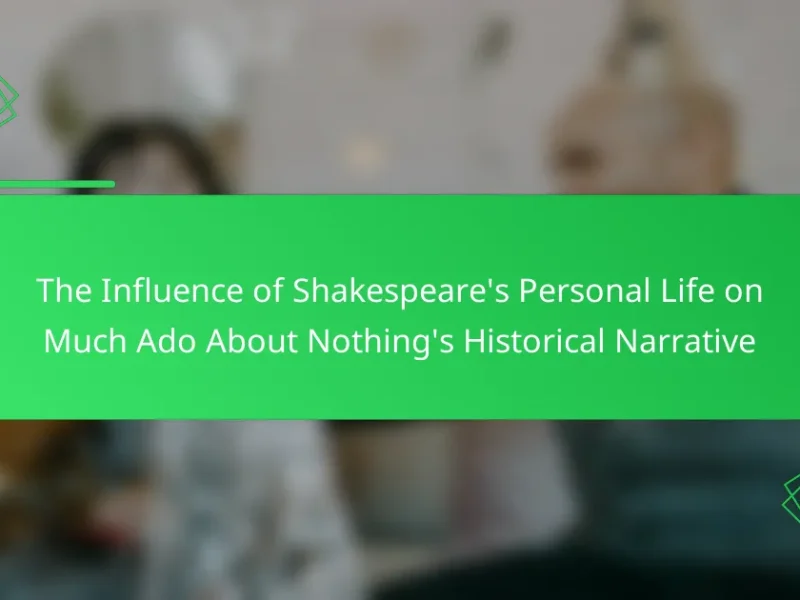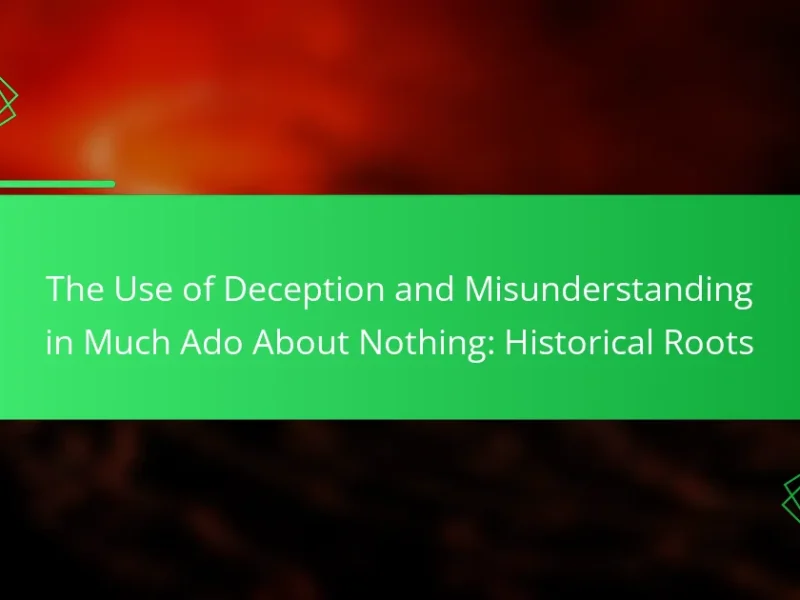
What is the Historical Significance of Much Ado About Nothing in Elizabethan Theater?
Much Ado About Nothing holds significant historical importance in Elizabethan theater as a quintessential example of Shakespearean comedy. This play showcases the era’s themes of love, deception, and social commentary. It reflects the complexities of gender roles and relationships during the Elizabethan period. The witty banter between characters highlights the value of language and wordplay in the time’s theatrical productions. Additionally, Much Ado About Nothing contributed to the development of the romantic comedy genre. Its exploration of mistaken identities resonates with audiences, influencing future playwrights. The play’s enduring popularity demonstrates its cultural relevance and impact on English literature.
How did Much Ado About Nothing reflect the cultural values of its time?
Much Ado About Nothing reflects the cultural values of its time through its exploration of gender roles and social hierarchy. The play highlights the expectations placed on women, particularly regarding fidelity and honor. Characters like Hero embody the idealized woman of the Elizabethan era, showcasing the importance of reputation. Conversely, Beatrice challenges these norms, representing a more progressive view of female independence. Additionally, the play critiques male authority and the consequences of jealousy, as seen in Claudio’s public shaming of Hero. The use of wit and wordplay underscores the value placed on intelligence and social interaction. Overall, the interactions and conflicts in the play mirror the societal dynamics of Elizabethan England, emphasizing themes of love, honor, and the complexities of human relationships.
What themes in Much Ado About Nothing resonate with Elizabethan society?
Themes in Much Ado About Nothing that resonate with Elizabethan society include love, honor, and deception. Love is portrayed through the romantic relationships between characters like Beatrice and Benedick. Their witty banter reflects the courtship rituals of the time. Honor is a critical theme, especially concerning the character of Hero. Her reputation is central to the plot, highlighting the societal importance placed on female virtue. Deception plays a significant role, as characters engage in trickery to achieve their goals. This mirrors the social dynamics of Elizabethan society, where appearances often masked true intentions. The interplay of these themes illustrates the complexities of relationships during the era. These elements collectively reflect the values and challenges faced by individuals in Elizabethan society.
How does the play address social hierarchies and gender roles of the period?
The play addresses social hierarchies and gender roles by depicting the expectations placed on men and women. It illustrates the patriarchal society of Elizabethan times. Male characters often exert power and control over female characters. For instance, Claudio’s public shaming of Hero highlights the consequences of a woman’s honor tied to male perceptions. Beatrice, however, challenges these norms through her wit and independence. Her character embodies resistance against traditional gender roles. The contrast between Beatrice and Hero showcases varying responses to societal expectations. Overall, the play critiques and reflects the complexities of gender dynamics within its historical context.
What role did Much Ado About Nothing play in the development of comedic theater?
Much Ado About Nothing significantly influenced the development of comedic theater. It showcased the use of witty dialogue and complex characters. The play introduced the trope of mistaken identities and misunderstandings, which became staples in comedies. Its exploration of love and social conventions added depth to comedic narratives. Additionally, the interplay between male and female characters highlighted gender dynamics humorously. This play also demonstrated the effectiveness of comedic timing and wordplay. These elements contributed to shaping future comedic works in the theater. Much Ado About Nothing remains a vital reference point for understanding the evolution of comedic storytelling.
How did Shakespeare’s approach to comedy differ from his contemporaries?
Shakespeare’s approach to comedy differed from his contemporaries by integrating complex characters and deeper themes. His comedies often explored human emotions and relationships with greater nuance. Unlike his contemporaries, who focused on simple misunderstandings and farce, Shakespeare infused his plots with wit and social commentary. For example, in “Much Ado About Nothing,” he presents strong, multifaceted characters like Beatrice and Benedick. This contrasts with the more one-dimensional comedic figures typical of the period. Shakespeare’s use of wordplay and clever dialogue also set him apart. His comedies often feature a blend of humor and serious undertones, reflecting the complexities of love and society. This innovative approach contributed to the lasting impact of his works in Elizabethan theater.
What innovations in storytelling and character development are present in the play?
Much Ado About Nothing introduces innovations in storytelling and character development through its use of witty dialogue and complex characters. The play features a unique blend of comedy and drama, showcasing the duality of human nature. Characters like Beatrice and Benedick exhibit depth through their evolving relationship, highlighting themes of love and misunderstanding. The use of mistaken identities and deception drives the plot, creating tension and humor. Additionally, the play’s structure allows for multiple perspectives, enriching the narrative. This complexity reflects the social dynamics of Elizabethan society, making the characters relatable and engaging. The interplay between honor and reputation further adds layers to character motivations. These elements contribute to the play’s enduring relevance and impact on future storytelling techniques.
Why is Much Ado About Nothing considered a pivotal work in Shakespeare’s oeuvre?
Much Ado About Nothing is considered a pivotal work in Shakespeare’s oeuvre due to its intricate exploration of themes such as love, deception, and social norms. The play showcases Shakespeare’s mastery of comedic elements and character development. It presents a complex interplay between wit and seriousness, allowing for both humor and deeper reflections on human relationships. The characters of Beatrice and Benedick are particularly notable for their strong personalities and witty banter, which have become iconic in literature. Additionally, the play’s structure, blending romantic comedy with elements of drama, reflects the evolving nature of Elizabethan theater. Its enduring popularity and frequent adaptations further underscore its significance in Shakespeare’s body of work.
What literary techniques does Shakespeare employ in Much Ado About Nothing?
Shakespeare employs various literary techniques in Much Ado About Nothing. Notable techniques include wordplay, puns, and dramatic irony. Wordplay enhances the wit and humor of the dialogue. Puns create layers of meaning and engage the audience. Dramatic irony allows the audience to be aware of situations that characters are not. This technique builds tension and anticipation. Additionally, Shakespeare uses soliloquies to provide insight into characters’ thoughts. The use of asides creates a connection between characters and the audience. These techniques contribute to the play’s exploration of love, deception, and social dynamics.
How has the play influenced subsequent works in theater and literature?
The play “Much Ado About Nothing” has significantly influenced subsequent works in theater and literature. Its exploration of themes such as love, deception, and social dynamics has inspired countless adaptations and reinterpretations. The witty dialogue and complex characters set a precedent for romantic comedies. Many playwrights, including those in the Restoration and Romantic periods, drew from its character archetypes and plot devices. Additionally, its impact can be seen in modern films and novels that echo its comedic elements and intricate relationships. The enduring popularity of “Much Ado About Nothing” showcases its foundational role in shaping narrative structures in Western literature.
How did the performance context of Elizabethan theater shape Much Ado About Nothing?
The performance context of Elizabethan theater significantly shaped Much Ado About Nothing. Elizabethan theater was characterized by outdoor venues and a diverse audience. This context influenced the play’s comedic elements and engaging dialogue. The use of shared space allowed for direct interaction between actors and spectators. Additionally, the limited stage technology required creative storytelling techniques. The presence of a lively audience encouraged dynamic performances and improvisation. The popularity of the genre also affected the play’s themes, focusing on love and social dynamics. Historical records indicate that Much Ado About Nothing was performed at the Globe Theatre, enhancing its accessibility. This setting contributed to its enduring appeal and relevance in the theatrical landscape.
What were the typical characteristics of Elizabethan theater productions?
Elizabethan theater productions typically featured elaborate staging, a diverse range of genres, and a focus on spoken dialogue. The use of outdoor venues like the Globe Theatre allowed for large audiences. Performances often included a mix of tragedy, comedy, and history. Actors were predominantly male, with young boys playing female roles. Costumes were vibrant and reflected contemporary fashion. The absence of elaborate scenery meant that props and costumes conveyed much of the setting. Live music and dance were integral to the performances. These characteristics contributed to the rich cultural landscape of the Elizabethan era.
How did audience reception impact the play’s historical significance?
Audience reception significantly impacted the historical significance of “Much Ado About Nothing.” Positive reactions from the audience contributed to its enduring popularity. The play’s comedic elements resonated with viewers, fostering a connection to Elizabethan culture. Audience engagement also influenced the play’s performance frequency. High demand led to more productions, solidifying its place in theatrical history. Critical acclaim from contemporaries further enhanced its reputation. The play’s ability to reflect societal norms made it relevant across generations. Overall, audience reception played a crucial role in establishing the play’s lasting legacy.
What lessons can be learned from the historical significance of Much Ado About Nothing today?
Much Ado About Nothing teaches lessons about social dynamics and the consequences of deception. The play highlights the importance of communication in relationships. Misunderstandings arise from lack of clarity, leading to conflict. This reflects the societal norms of Elizabethan times regarding honor and reputation. The characters’ experiences demonstrate the dangers of gossip and assumptions. Additionally, the resolution emphasizes forgiveness and reconciliation. These themes remain relevant in today’s interpersonal interactions. Understanding these lessons can improve modern social relationships and conflict resolution strategies.
How can modern productions of the play reflect its historical context?
Modern productions of “Much Ado About Nothing” can reflect its historical context through various methods. They can incorporate period-specific costumes and settings that mirror Elizabethan society. This includes using authentic fabrics and styles that were prevalent during Shakespeare’s time. Additionally, modern adaptations can emphasize themes relevant to the historical context, such as gender roles and social class dynamics.
Directorial choices can also highlight the play’s commentary on courtship and marriage customs of the era. For instance, staging the play in a way that showcases the power dynamics between men and women can provide insight into Elizabethan norms. Furthermore, incorporating contemporary issues that parallel those of the past can create a dialogue between the historical and modern audiences.
By utilizing these techniques, productions can effectively bridge the gap between Shakespeare’s time and today, allowing audiences to engage with the historical significance of the play.
What can contemporary audiences gain from understanding its historical significance?
Contemporary audiences can gain insights into societal norms and values from understanding the historical significance of Much Ado About Nothing. The play reflects the dynamics of gender roles in Elizabethan society. It showcases the expectations placed on women and men during that era. Additionally, it illustrates the importance of honor and reputation in social interactions. Understanding these elements provides context for character motivations and conflicts. Historical analysis reveals how the play critiques and reinforces these norms. This knowledge enhances appreciation for the text’s complexity and relevance. Audiences can draw parallels to modern societal issues, enriching their viewing experience.
Much Ado About Nothing is a significant work in Elizabethan theater, exemplifying Shakespearean comedy through its exploration of themes such as love, deception, and social commentary. The play reflects the cultural values of its time, particularly regarding gender roles and social hierarchies, while also influencing the development of the romantic comedy genre. Key attributes include its use of witty dialogue, complex characters, and innovative storytelling techniques that resonate with audiences and have shaped subsequent works in theater and literature. The historical context of Elizabethan performance further enhances the play’s relevance, providing insights into societal norms and dynamics that continue to inform modern interpretations.


